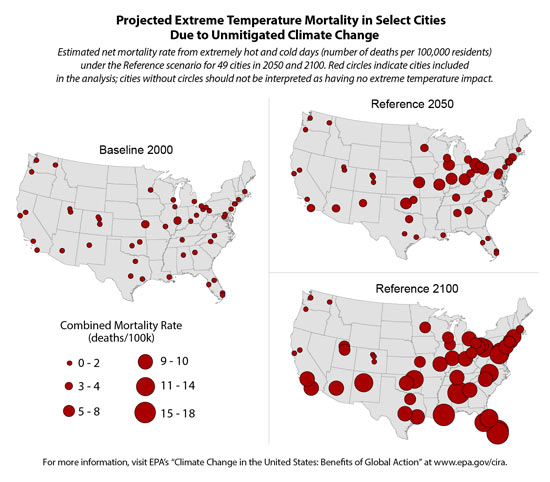Heat Waves and Climate Change: Learning from History and Looking Ahead
By Allison Crimmins
Twenty years ago this week, Chicago suffered from a historic heat wave. Families tried to stay cool in backyard wading pools and the news begged people to check on their older neighbors, who refused to turn on their air conditioning because it would cost too much. An estimated 700 people died from the heat during that two-week period, many of them elderly (learn more about heat-related mortality). Behind this grim statistic were real people and communities. An oral history of the heat wave published last week by Chicago Magazine has eloquently captured some of these stories of suffering.
 We know climate change will bring more frequent and intense heat waves to the U.S. Twenty years later, are we twenty years wiser? In terms of preparing for another heat wave or “adaptation planning,” I’d say yes. Chicago’s Climate Action Plan is working to make the city cooler through urban planning (such as preserving green landscapes) and becoming better prepared to respond to future heat waves. But what about addressing the greenhouse gas emissions causing those more frequent and intense heat waves in the first place?
We know climate change will bring more frequent and intense heat waves to the U.S. Twenty years later, are we twenty years wiser? In terms of preparing for another heat wave or “adaptation planning,” I’d say yes. Chicago’s Climate Action Plan is working to make the city cooler through urban planning (such as preserving green landscapes) and becoming better prepared to respond to future heat waves. But what about addressing the greenhouse gas emissions causing those more frequent and intense heat waves in the first place?
EPA’s recently released report Climate Change in the United States: Benefits of Global Action looks at projected heat-related deaths in 49 U.S. cities (representing about 1/3 of the population) under two scenarios: one where the world takes action to cut global emissions and one where it doesn’t. The risks of inaction are sobering. Without action to reduce global greenhouse gases, the average number of extremely hot days is projected to more than triple from 2050 to 2100. But there is good news. Taking action on global climate change is estimated to result in significant public health benefits by substantially reducing the risk of extreme temperature-related deaths across the U.S. Extreme temperature mortality can be reduced by 64% in 2050 and by 93% in 2100, compared to the scenario where the world does not take action to reduce greenhouse gas emissions. That means approximately 12,000 fewer people could die each year from extreme temperature in the 49 modeled cities in 2100. Inclusion of the entire U.S. population would increase these numbers. Activities to adapt to more frequent heat events can help reduce heat mortality, but reducing emissions is still important to saving lives. Including the assumption that cities take significant steps to prepare for extreme heat into the analysis, emissions reductions could still prevent 5,500 deaths per year by the end of the century.
But there is good news. Taking action on global climate change is estimated to result in significant public health benefits by substantially reducing the risk of extreme temperature-related deaths across the U.S. Extreme temperature mortality can be reduced by 64% in 2050 and by 93% in 2100, compared to the scenario where the world does not take action to reduce greenhouse gas emissions. That means approximately 12,000 fewer people could die each year from extreme temperature in the 49 modeled cities in 2100. Inclusion of the entire U.S. population would increase these numbers. Activities to adapt to more frequent heat events can help reduce heat mortality, but reducing emissions is still important to saving lives. Including the assumption that cities take significant steps to prepare for extreme heat into the analysis, emissions reductions could still prevent 5,500 deaths per year by the end of the century.
Scientists have been calling on the world to reduce carbon pollution for more than twenty years. The United States has the opportunity and the ability to lead the world in global actions to cut carbon pollution that, by the end of this century, could avoid 12,000 heat-related deaths each year– not to mention save the lives of 57,000 people every year who could die prematurely from the adverse air quality impacts associated with climate change. I can think of no more important reason than that to take action on climate change now. About the author: Allison Crimmins is an environmental scientist with EPA’s Climate Change Division, where she focuses on the impacts and risks associated with climate change, especially on human health. Prior to joining EPA, she earned one Masters degree in oceanography by exploring past climates in ocean sediments and a second Masters’ degree in public policy from the Harvard Kennedy School. She lives, works, and judges the occasional science fair in Washington, D.C. but still cheers for the Chicago Bears.
About the author: Allison Crimmins is an environmental scientist with EPA’s Climate Change Division, where she focuses on the impacts and risks associated with climate change, especially on human health. Prior to joining EPA, she earned one Masters degree in oceanography by exploring past climates in ocean sediments and a second Masters’ degree in public policy from the Harvard Kennedy School. She lives, works, and judges the occasional science fair in Washington, D.C. but still cheers for the Chicago Bears.
